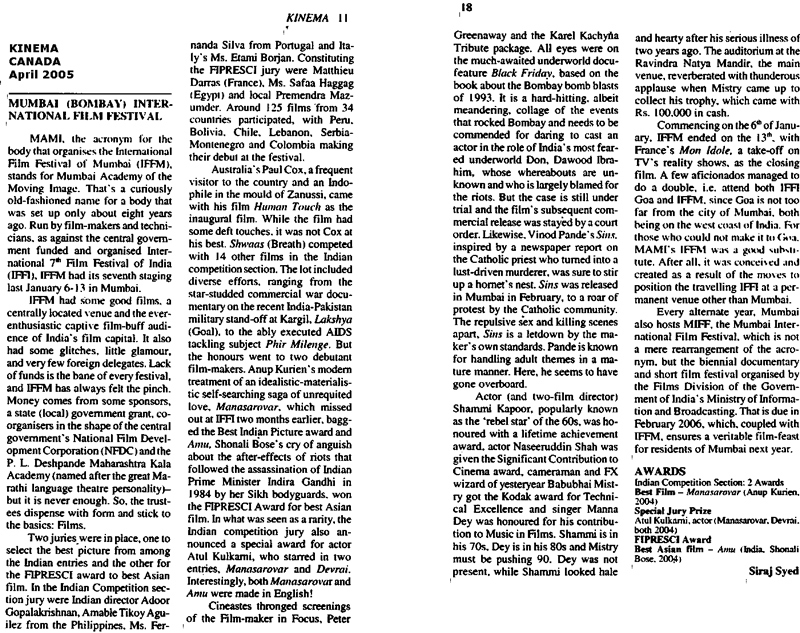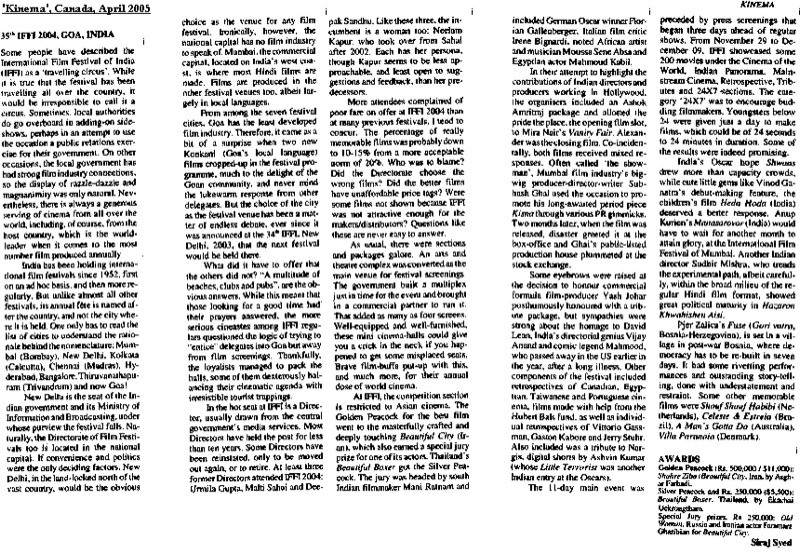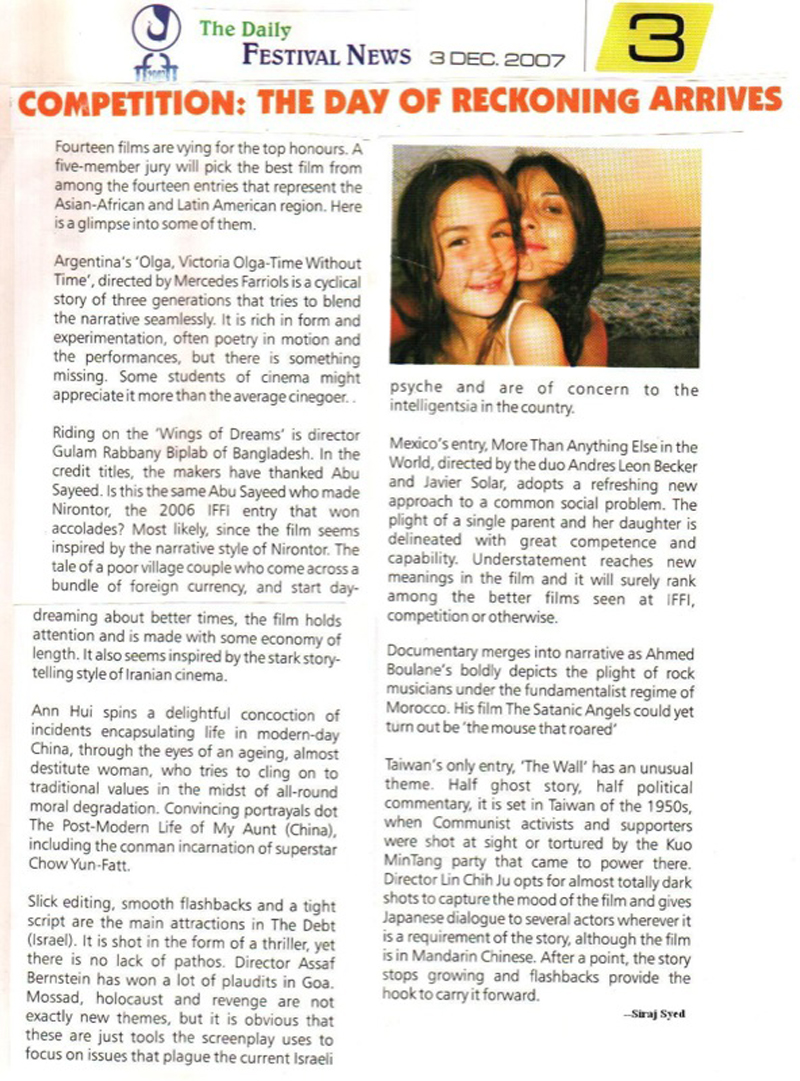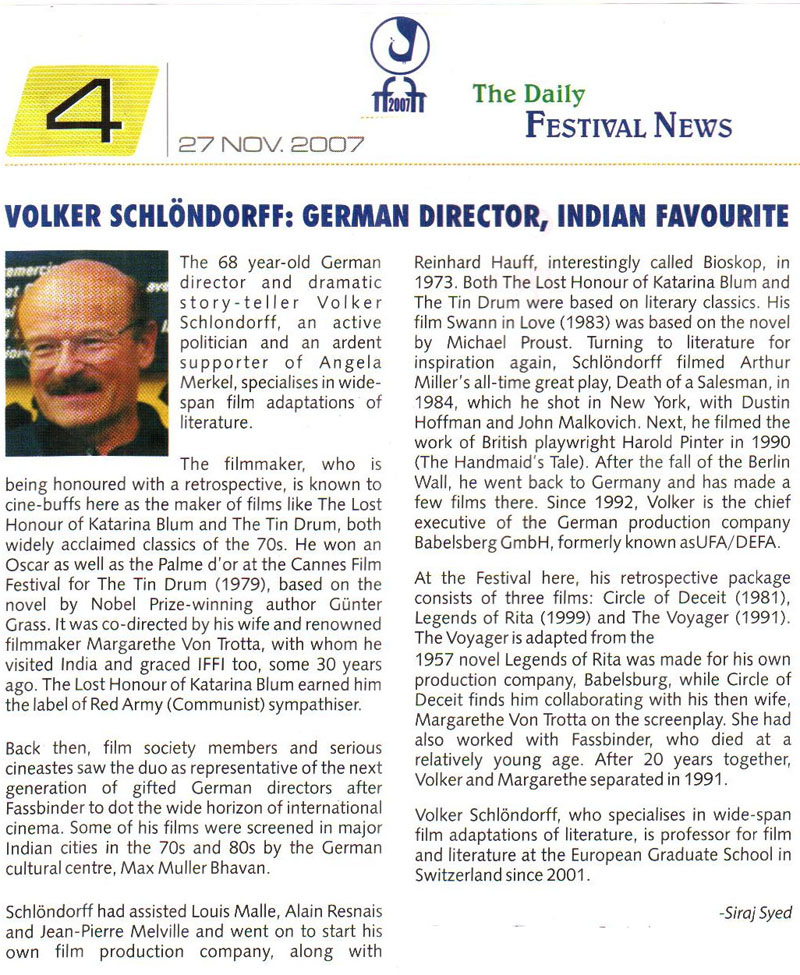|
|
||
|
Pro Tools
FILMFESTIVALS | 24/7 world wide coverageWelcome ! Enjoy the best of both worlds: Film & Festival News, exploring the best of the film festivals community. Launched in 1995, relentlessly connecting films to festivals, documenting and promoting festivals worldwide. Working on an upgrade soon. For collaboration, editorial contributions, or publicity, please send us an email here. User login |
1917, Review: One shot wonder, real-time revolution
1917, Review: One shot wonder, real-time revolution War films can be about nations and nationalism, or soldiers and their sagas. While the former promote jingoism, the latter tend to be anti-war, by personalising the narrative and addressing personal trauma of the protagonists, while universalising their sentiments. 1917 belongs to the second category. It is a technical marvel, but never wavers from the plight of its main characters. All the awards and encomiums it has garnered, raising expectations sky high, are, however, something the film could have done without. 1917 chronicles roughly one day, April 6, 1917, during the First World War (1914-18).The Germans have pulled back from a sector of the Western Front, in northern France. General Erinmore briefs two young, awarded British soldiers, Sergeant Blake and Lance Corporal Schofield, about a mission they are to undertake. Aerial intelligence has learned that the Germans are not in headlong retreat, as believed, but have made a tactical withdrawal to their new Hindenburg Line, where they have prepared to overwhelm the attacking British forces with their superior artillery. With field telephone lines cut, Blake and Schofield are ordered to hand-deliver a message to the 2nd Battalion of the Devonshire Regiment, calling off their planned, all-out attack against the retreated Germans, which might cost the lives of 1,600 men. Blake's brother, Joseph, is among them. Schofield and Blake cross no man's land and reach the original German trenches, now abandoned. The trenches turn out to contain trip-wires, one of which a rat triggers. The ensuing explosion almost kills Schofield, but Blake digs him out from the debris, and leads him out of the collapsing bunkers. They arrive at an abandoned farm-house, where they witness a dog-fight nearby, in which two Allied aeroplanes have cornered a German aircraft. The German plane plunges into the farm and Schofield and Blake attempt to save the pilot, whose body is on fire. Schofield proposes they mercy kill him, but Blake asks Schofield to fetch water, instead, for the pilot to drink. The pilot stabs Blake and is shot dead by Schofield, who comforts Blake as he dies, promising to complete the mission. Written by director Sam Mendes (aged 54; British; American Beauty, Skyfall, Spectre) himself, with Krysty Wilson-Cairns, 1917 is conceived as a one shot, real-time film, following its two protagonists (later a solo character) and panning only to reach other characters. It uses zooms, tilts, tracking and other camera attributes as and when required. Though this method is a technical wonder, and might have been achieved during post-production, it would have to be designed at the concept stage, and involved numerous rehearsals, to ensure smooth movement and memorising of dialogue. Credits also include a mention of Alfred Mendes, “Who told us the stories”. Alfred was the paternal grandfather of Sam, and the film is partly based on those stories. Blood and gore are at the core of this messenger, friendship and brotherhood story, in a trench warfare milieu. You see corpses by the dozen, in various stages of decay and decomposition. What is worse, the protagonist accidentally digs his hand into the innards of one such cadaver and has to cross a river bank by climbing over several of his fellow soldiers. His partner dies a bloody death, of a ghastly knife-wound, inflicted by an enemy pilot, whose life they are trying to save. You see dozens of badly wounded soldiers either being carried on stretchers or being tended by medical staff. Some of them are hollering, others are facing amputation of their limbs. It requires nerves of steel to sit through all of this, with your eyes open and your face upright. Krysty Wilson-Cairns (Penny Dreadful-produced by Sam Mendes, Last Night in Soho) is a Scottish writer. Scenes for 1917 were shot at the A-listed Govan Graving Docks in Glasgow, a location where her grandfather worked 90 years ago. She and Mendes worked out the actual physical, geographical journey that the boys would go on, by consulting maps. The way she and Mendes have treated the death of Blake, which comes early in the film, commands appreciation. There is hardly any mourning, no grave dug, no funeral, only showing him carried and laid to rest on the ground, with his head propped up. It’s relentless, without a cut. And a cut is ruled out, because by then the audience knows that there are going to be no cuts in this film. Wilson-Cairns read some 200 first-hand accounts of the war and resisted pressure from the studio to turn General Mackenzie into a cartoon, monster villain. There are issues, some of them related to the real time frame-work. An eight-hour journey is completed into two hours. Night turns to day in a matter of minutes. Schofield’s helmet is missing in the second half, as is his bayonet. Yes, he is hit by a ricocheting bullet that could have knocked of his helmet, but it was vital that he retrieve it. Regarding the bayonet, he is not shown removing it, and this being real time, that is a loss of continuity. The Germans have moved out and the British command has aerial pictures of their withdrawal, an exercise that must have taken considerable time, and would have been noticed by the British ground forces too. It is not noticed by either. When the two messengers enter the abandoned German camp, a fire is still burning. Firstly, the perfectionist Germans would have not left any fire burning, and secondly, it would mean that they have just departed, whereas they have left a considerable amount of time ago, to set base at the new location and get photographed by British reconnaissance planes. A rat triggering of the trip-wire and causing an explosion just when the duo is in its ambit, a bucketful of milk left for the duo to access, and a plane crashing right into the barn where are at that instant seem too much of co-incidences to be true. When pursued by and shot at by the Germans, William just keeps running and hiding, never once firing back. Also, the introduction of a woman and a baby, with William offering everything he has to her, including a canister full of milk, for heart-tugging effect, seems contrived, especially with the English-French language exchange between her and William. An attempt is made to justify the incident at the very end of the film, in its last shot, which partly succeeds in making the earlier co-incidence appear credible and plausible. After all he undergoes, including falling into a river and falling off a water-fall, the letter William is carrying remains dry and intact. However well protected it might have been, it would surely not survive such an ordeal. Although the duo, and especially William, gets jostled as they make their way through hordes of soldiers, they manage to get their passage every time, without any real attempts to stop them. When Will reaches the Devons, he walks up to them as they are listening to a soldier singing a song, and an entire battalion fails to notice an intruder, who could easily have been an enemy crawling up on them and attacking, from behind, with arms. What kind of army is that? Performances are uniformly (pun intended) above par, with the two protagonists matching veterans like Colin Firth and Benedict Cumberbatch in histrionics. They both come across as men in their early 20s, though Mackay is 27 in real life. He showed good presence of mind when an actor collided with him and he fell as a result. Filming a scene where he runs along a trench as the British army charges ahead, he was never meant to collide with another actor and fall down, as he does in the movie. “That’s a mistake that made it in. That wasn’t meant to happen,” MacKay explained. “And again, we’d rehearsed it for weeks, and we’d rehearsed that he didn’t get knocked into, and then on the day, you know, you take some hits. But the rule is you don’t stop unless they say ‘stop,'” he told The Wrap. George MacKay (27; For Those in Peril, Captain Fantastic, Ophelia) is cast as Lance Corporal Will Schofield. Dean-Charles Chapman (22; The Commuter, Blinded by the Light, The King) plays Lance Corporal Tom Blake, and is the baby of the film, yet shows great maturity. Others in the cast include Mark Strong as Captain Smith Andrew Scott as Lieutenant Leslie Richard Madden as Lieutenant Joseph Blake Claire Duburcq as Lauri Colin Firth as General Erinmore Benedict Cumberbatch as Colonel Mackenzie Nabhaan Rizwan (lead role of crime thriller series Informer, his mother being Bollywood actress and writer Shahnaz Rizwan, and his brother, Mawaan, an actor and comedian) as Sepoy Music by Thomas Newman is a highlight while Roger Deakins excels with 6-7 minute takes and a fluidity of the camera that is remarkable. Editor Lee Smith must be complimented for compressing a sprawling war narrative into just 119 minutes, with almost invisible shot transitions. A large part of the success of the film is due to its cinematography, editing and post-production. Two scenes will linger long after the film is over: the dog-fight and plane crash, and the dance of the light and shade shadows. Several expletives have been beeped out, most likely to avoid a stricter certification by the Board. Not in The Longest Day or Dunkirk league, 1917 is inspired more by Saving Private Ryan than any other film. That is not to say that it has copied anything from the Spielberg milestone. Much hyped and highly decorated, 1917 is a good film, but not superlative, film on the theme, ‘Time is the enemy’. This reviewer is impressed, not overawed. Nevertheless, it deserves to be seen. Rating: *** Trailer: https://www.youtube.com/watch?v=YqNYrYUiMfg 17.01.2020 | Siraj Syed's blog Cat. : Andrew Scott anti-war Benedict Cumberbatch Claire Duburcq Colin Firth Dean-Charles Chapman George MacKay Krysty Wilson-Cairns Lee Smith Mark Strong Mawaan Nabhaan Rizwan Richard Madden Roger Deakins Sam Mendes Shahnaz Rizwan Thomas Newman World war I Hollywood FILM
|
LinksThe Bulletin Board > The Bulletin Board Blog Following News Interview with EFM (Berlin) Director
Interview with IFTA Chairman (AFM)
Interview with Cannes Marche du Film Director
Filmfestivals.com dailies live coverage from > Live from India
Useful links for the indies: > Big files transfer
+ SUBSCRIBE to the weekly Newsletter Deals+ Special offers and discounts from filmfestivals.com Selected fun offers
> Bonus Casino
User imagesAbout Siraj Syed Syed Siraj Syed Siraj (Siraj Associates) Siraj Syed is a film-critic since 1970 and a Former President of the Freelance Film Journalists' Combine of India.He is the India Correspondent of FilmFestivals.com and a member of FIPRESCI, the international Federation of Film Critics, Munich, GermanySiraj Syed has contributed over 1,015 articles on cinema, international film festivals, conventions, exhibitions, etc., most recently, at IFFI (Goa), MIFF (Mumbai), MFF/MAMI (Mumbai) and CommunicAsia (Singapore). He often edits film festival daily bulletins.He is also an actor and a dubbing artiste. Further, he has been teaching media, acting and dubbing at over 30 institutes in India and Singapore, since 1984.View my profile Send me a message The EditorUser contributions |




























